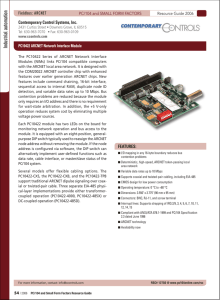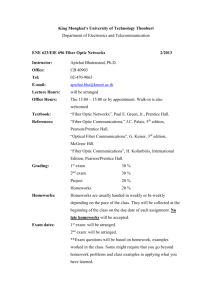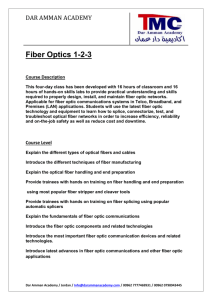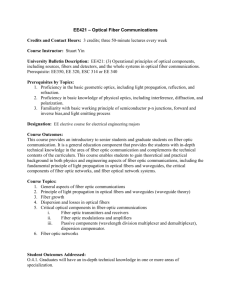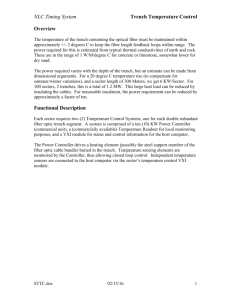ARCNET® Plays Integral Role in Postal Sorting Machines Across
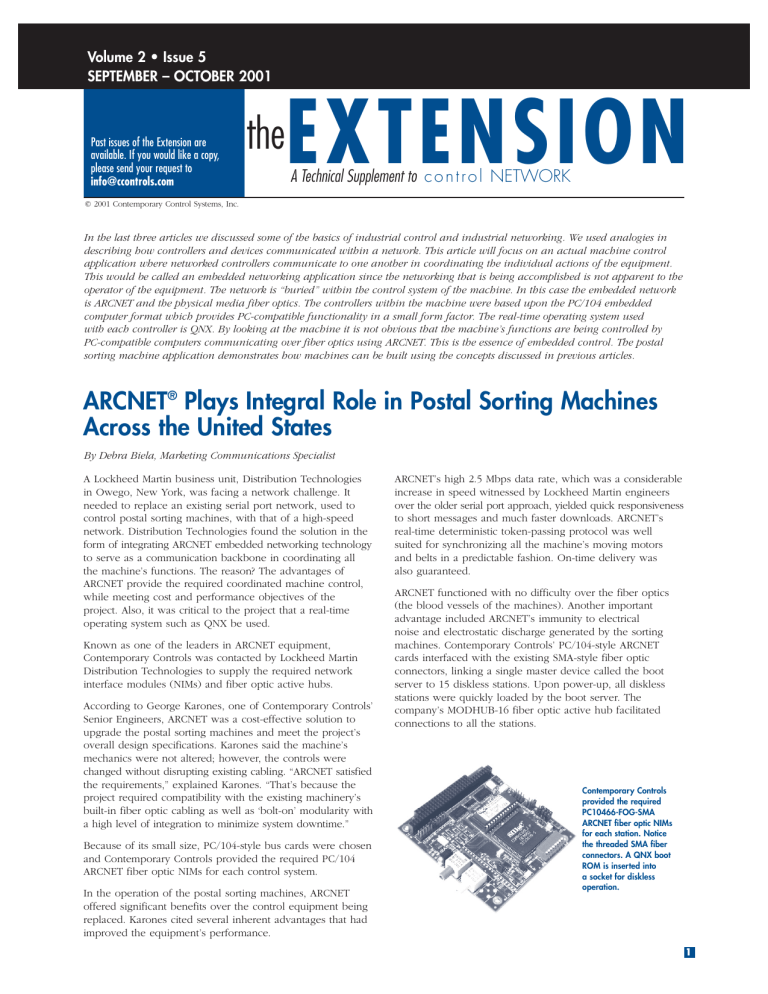
Volume 2 • Issue 5
SEPTEMBER – OCTOBER 2001
Past issues of the Extension are available. If you would like a copy, please send your request to info@ccontrols.com
the
EXTENSION
A Technical Supplement to
c o n t r o l NETWORK
© 2001 Contemporary Control Systems, Inc.
In the last three articles we discussed some of the basics of industrial control and industrial networking. We used analogies in describing how controllers and devices communicated within a network. This article will focus on an actual machine control application where networked controllers communicate to one another in coordinating the individual actions of the equipment.
This would be called an embedded networking application since the networking that is being accomplished is not apparent to the operator of the equipment. The network is “buried” within the control system of the machine. In this case the embedded network is ARCNET and the physical media fiber optics. The controllers within the machine were based upon the PC/104 embedded computer format which provides PC-compatible functionality in a small form factor. The real-time operating system used with each controller is QNX. By looking at the machine it is not obvious that the machine’s functions are being controlled by
PC-compatible computers communicating over fiber optics using ARCNET. This is the essence of embedded control. The postal sorting machine application demonstrates how machines can be built using the concepts discussed in previous articles.
ARCNET
®
Plays Integral Role in Postal Sorting Machines
Across the United States
By Debra Biela, Marketing Communications Specialist
A Lockheed Martin business unit, Distribution Technologies in Owego, New York, was facing a network challenge. It needed to replace an existing serial port network, used to control postal sorting machines, with that of a high-speed network. Distribution Technologies found the solution in the form of integrating ARCNET embedded networking technology to serve as a communication backbone in coordinating all the machine’s functions. The reason? The advantages of
ARCNET provide the required coordinated machine control, while meeting cost and performance objectives of the project. Also, it was critical to the project that a real-time operating system such as QNX be used.
Known as one of the leaders in ARCNET equipment,
Contemporary Controls was contacted by Lockheed Martin
Distribution Technologies to supply the required network interface modules (NIMs) and fiber optic active hubs.
According to George Karones, one of Contemporary Controls’
Senior Engineers, ARCNET was a cost-effective solution to upgrade the postal sorting machines and meet the project’s overall design specifications. Karones said the machine’s mechanics were not altered; however, the controls were changed without disrupting existing cabling. “ARCNET satisfied the requirements,” explained Karones. “That’s because the project required compatibility with the existing machinery’s built-in fiber optic cabling as well as ‘bolt-on’ modularity with a high level of integration to minimize system downtime.”
Because of its small size, PC/104-style bus cards were chosen and Contemporary Controls provided the required PC/104
ARCNET fiber optic NIMs for each control system.
In the operation of the postal sorting machines, ARCNET offered significant benefits over the control equipment being replaced. Karones cited several inherent advantages that had improved the equipment’s performance.
ARCNET’s high 2.5 Mbps data rate, which was a considerable increase in speed witnessed by Lockheed Martin engineers over the older serial port approach, yielded quick responsiveness to short messages and much faster downloads. ARCNET’s real-time deterministic token-passing protocol was well suited for synchronizing all the machine’s moving motors and belts in a predictable fashion. On-time delivery was also guaranteed.
ARCNET functioned with no difficulty over the fiber optics
(the blood vessels of the machines). Another important advantage included ARCNET’s immunity to electrical noise and electrostatic discharge generated by the sorting machines. Contemporary Controls’ PC/104-style ARCNET cards interfaced with the existing SMA-style fiber optic connectors, linking a single master device called the boot server to 15 diskless stations. Upon power-up, all diskless stations were quickly loaded by the boot server. The company’s MODHUB-16 fiber optic active hub facilitated connections to all the stations.
Contemporary Controls provided the required
PC10466-FOG-SMA
ARCNET fiber optic NIMs for each station. Notice the threaded SMA fiber connectors. A QNX boot
ROM is inserted into a socket for diskless operation.
1
The larger board is a multi-function input/output (I/O) board with one PC/104 site. A PC/104 CPU module and Contemporary Controls’ ARCNET NIM are stacked in the corner. The MODHUB can support up to 16 fiber optic ports.
Whereas many other systems require layers of software to operate and talk over the network, diagnostic functions such as error checking, flow control and network configuration were done automatically by ARCNET without software intervention. For these reasons, ARCNET is an ideal embedded networking technology.
Also, ARCNET is directly supported by each machine’s QNX
Software Systems’ real-time operating system. It allowed for one centralized server location to store all the processes so any configuration changes were automatically directed to the individual computers located along the postal sorting machine. The real-time control of both ARCNET and QNX provided cost-effective performance.
Sorting machines are located in major postal distribution and processing (P&DC) centers throughout the United States.
Each machine is nearly 150 ft. long and has three key functions: induction, transport and delivery. Each induction station and the eighth, 12th and 16th delivery bins are computer controlled
Once inducted, the control system will determine where the parcels will be routed.
for a total of 16 computers distributed throughout the machine. One PC/104-style ARCNET card is equipped in the boot server and one in each of the diskless computers.
Connection to the network is through the machine’s existing fiber optic cabling.
Within the induction station the parcels drop down onto the belt and the zip codes are keyed in either by the bar code reader or a human operator. The parcel has now been inducted into the machine’s process. The control system understands the parcel has a zip code, which will determine where it will be delivered, and makes a note of the parcel’s destination.
The induction stations feed a long transport belt comprised of individual cells. The parcel moves along a series of conveyor belts until it is synchronized to the transport belt and directed into one of these cells. The control system sends a message to an output module that controls the destination bin. The module monitors passing cells, and parcels are dropped into correct bins based on destination.
This modular architecture allows the machine to be configured per the mail volume of the facility.
To conclude, Lockheed Martin’s Distribution Technologies unit found a simple and manageable way to upgrade the performance of a large machine by using modular technology.
For Lockheed Martin’s embedded application, ARCNET succeeded in both cost-savings and functionality—
Contemporary Controls’ industrial networking equipment was the key for a practical and successful implementation.
2
At the induction stations, postal service operators key in zip codes for the parcels.
ARCNET and Fiber Optics—How Do They Relate to the OSI Model?
The network technology used by the postal sorting machine is ARCNET and the cabling is fiber optics. In our Extension articles we frequently mention the seven-layer OSI
Communication Model when we explain how a system functions. A collapsed stack of three layers is best used to explain the operation of the postal sorting machine. The three layers are the Physical, Data Link and Application layers. We will clarify all three as they apply to the postal sorting machine.
Flow control ensures that a node receiving transmissions is in a position to accept transmissions without overflowing its receive buffers. If this occurs, transmissions will be lost. Before an ARCNET transmission occurs, a Free Buffer Enquiry (FBE) is sent by the originating station to the destination station.
If a receive buffer is available, the destination station will respond with an ACK (acknowledgement); otherwise, it will send a NAK (negative acknowledgement). If an ACK is sent, the originator will send the message. If a NAK is sent, the originator will try again on the next token pass. Using this approach, no messages are lost due to buffer overflows.
Application Layer
Each node (station) of the postal sorting machine consists of a PC-compatible computer running the QNX 4.24 operating system. QNX Software Systems Ltd. of Kanata, Ontario, Canada produces the QNX Real-Time Operating System. One node in the machine is designated a QNX server. The other nodes are all diskless stations meaning that they must first be downloaded from the QNX server before they achieve a “personality.”
In order to affect the download, a small program called a bootstrap loader is executed at each diskless station. This program resides in ROM (read only memory) and is located on Contemporary Controls’ PC10466-FOG-SMA ARCNET Fiber
Optic Network Interface Module. A copy of the QNX operating system is downloaded from the QNX server over ARCNET when the bootstrap loader is executed. That is why ARCNET’s high speed (2.5 Mbps) is important in order to shorten the machine’s initialization time. Once all nodes are downloaded, the machine is functional and can begin processing parcels.
The QNX operating system occupies the application layer of the collapsed OSI stack. ARCNET occupies the data link and physical layers.
Guaranteed message delivery is the goal of any robust network and ARCNET helps here as well. A message sent by an originating station is tested by the receiving node for integrity by performing a CRC-16 (cyclic redundancy check).
If the test is successful, the destination node sends out an
ACK. If it does not pass the test, the destination node does nothing causing the originating node to time out. If an ACK is received by the originating node, the originating node knows that the transmission was a success. All this transport layer functionality is built into the ARCNET link layer protocol.
Physical Layer
Traditional ARCNET only supported coaxial cable as the medium and the Physical Layer Signaling (PLS) was a single dipulse for a logic “1” and silence for logic “0.” It was only later that twisted-pair and fiber optic interfaces were introduced. The original dipulse consisted of a single
5 Mhz sinusoid followed by 200 ns of silence. Since there was no DC component in the waveshape, it was suitable for transformer coupled designs and that is what was used for both unbalanced coaxial cable and balanced twisted pair.
Fiber optics has superior isolation to transformer-coupled designs so there was no need to use a dipulse for signaling.
The QNX operating system incorporates a built-in ARCNET driver. Therefore, the system engineer does not need to write complex communication software. The system engineer only needs to follow the rules for transferring data over ARCNET.
These rules require the system engineer to adhere to a specific
API (Applications Programming Interface). By following the rules established by QNX, communication over ARCNET is transparent to the system engineer. The system engineer interacts at the application layer of the OSI model of this collapsed stack. QNX worries about all the issues involved in connecting their real-time operating system to the ARCNET data link layer. This would be called a monolithic driver since no layering of software occurs. The application layer directly accesses the ARCNET hardware which in this case is
Contemporary Controls’ ARCNET NIM. By avoiding a layered approach, access to the network is faster.
At 2.5 Mbps, one bit-time is 400 ns wide. A dipulse occupies the first 200 ns of this bit-time. The remainder is silence. There are two internal signals that create the dipulse called P1 and P2.
These are two 100 ns wide signals that are sent back to back when a logic “1” bit is to be sent. P1 would help create the positive going pulse of the dipulse while P2 would create that negative going pulse yielding a zero average value of the voltage in the waveshape. With fiber there is no concern about bias currents that can saturate a transformer’s core so the practice was to use P1 to drive the fiber optic transceivers. P2 provided no useful information so it was ignored. It is possible to drive the fiber with the logical sum of P1 and
Either P1 or P2 can be used for fiber optic signaling.
P2 (P1 + P2) and this will work as well. Fiber optics is immune to
EMI/RFI disturbances, lightning and ESD, making it attractive in harsh environments.
Data Link Layer
The data link layer is layer two on the OSI model and is occupied by ARCNET’s link layer protocol. ARCNET nodes or stations share the same medium; in this case fiber optics and, therefore, access to the medium must be mediated. ARCNET uses a token-passing protocol where the station with the token has sole access to the medium. There can be a total of 255 stations, but with the postal machines there are only 16.
ARCNET allows for two types of packets (data frames) to be sent. A broadcast packet is directed to all stations by signifying station 0 in the destination register of the packet. A unicast or directed transmission is sent to only one station by specifying that station’s address in the destination register. Although
ARCNET is generally considered occupying layers 1 and 2 of the
OSI model, it provides some layer 4 (transport layer) functionality such as flow control and guaranteed message delivery.
The postal sorting machine had one particular requirement.
Since all the controls were being retrofitted, it was very important for the existing fiber optic cables to be retained.
These fiber optic cables utilized the older SMA-style connector which secures the fiber with a continuous thread. Most modern fiber optic installations utilize either quarter-turn ST or push-on SC connectors. Re-terminating the numerous fiber ends would have been cost prohibitive; so Contemporary
Controls utilized SMA-style transceivers, instead of ST-style connectors, on the ARCNET NIMs and the 16-port MODHUB fiber optic hub. Retaining the existing fiber optic cabling and connectors greatly aided the retrofitting of the controls.
3
Knowing PC/104 technology and embedded control is gaining wide acceptance in the industry, the editors of PC/104
Embedded Solutions Magazine posed this question to CEO’s and key officers of PC/104-related companies: “Where is
PC/104 headed and how is your company focusing its energy to address these trends?”
Generally speaking, the individuals’ responses were positive. Most of them said PC/104 technology is here to stay. Companies are enhancing on the standards of PC/104 technology—taking such issues as ease of integration and flexibility beyond critical steps to meet real-time solutions without compromising price/performance needs.
With that in mind, we wanted to reprint George Thomas’ position on PC/104 technology as seen in the Spring 2001 issue of PC/104 Embedded Solutions Magazine .
By George Thomas,
President
The PC/104 bus remains the most recognizable bus for embedded applications. Both engineers and designers are knowledgeable about the PC/104 bus’ versatility in functioning with numerous operating systems. Its small form factor and rugged mounting makes it ideal as a mezzanine or expansion bus for single board computers. As advantages, if a specialized function needs to be added, a compatible module is presumably available from one of the many suppliers of PC/104 bus products. If two functions must be added, the modules can be stacked. That is not the case with competing small form factor boards defined as
OEM modules. Thus, a customer designs their single board computer or controller so as to accept the proprietary bus connections and footprint of the OEM module. In turn the customer is locked to one supplier for expansion modules.
Whereas the PC/104 bus is an open, unlicensed and documented bus well supported from multiple sources.
The PC/104 bus prevents the risk of being constrained to one supplier of expansion modules.
Contemporary Controls will expand its offering of PC/104 modules to meet our customers’ industrial and embedded networking requirements. Within the embedded market we support data link layer technologies such as ARCNET,
Controller Area Network (CAN) and Industrial Ethernet. With embedded networking applications, the customer is usually not interested in connectivity outside their own equipment.
Frequently the customer develops their own application layer protocol specifically addressing the project’s performance issues.To assist the customer, we provide network driver software for the most popular operating systems so that the customer is not burdened with writing complicated communications software.
The PC/104 bus provides good performance, and it is well understood by design engineers.
Most importantly for us, it is an open standard and several industrial
The situation is different with industrial networking applications. In this instance the customer connects their proprietary equipment to one of the recognized fieldbuses to gain access to a wide range of industrial controllers. Therefore, we will need to provide fieldbus protocol stacks embedded
computers incorporate a PC/104 site onto their boards for expansion purposes.
into our PC/104 networking modules to address this necessity. Of importance would be fieldbus protocols such as DeviceNet,
CANopen, BACnet, MODBUS
TCP and the new EtherNet/IP initiative. With the continual miniaturization of electronics, we can provide more networking functionality onto a single PC/104 module by adding intelligence. In this way not only is performance enhanced, but the customer is removed from the complexities of fieldbus protocols.
We see the PC/104 popularity continuing since not all applications require a high performance bus. The PC/104 bus provides good performance, and it is well understood by design engineers. Most importantly for us, it is an open standard and several industrial computers incorporate a PC/104 site onto their boards for expansion purposes. This allows us to design our communication modules to match the most recognizable standard in the embedded marketplace.
4
